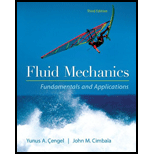
The drag force acting on the wall.
The drag force when the velocity is doubled.
Answer to Problem 59P
The drag force acting on the wall when velocity is
The drag force acting on the wall when velocity is
Explanation of Solution
Given information:
The wind velocity is
Write the expression for the Reynolds number.
Here, the velocity of flow is
Write the expression for the frictional coefficient.
Write the expression for the area of the wall.
Here, the length of the wall is
Write the expression for the drag force when the pressure drag is zero.
Here, the density of air is
Calculation:
Refer to Table A-9, “Properties of air” to obtain the values of
Substitute
The flow is laminar and turbulent as the obtained value of Reynolds number is greater than the critical Reynolds number.
Substitute
Substitute
Substitute
The velocity is doubled as stated.
Substitute
Substitute
Substitute
Conclusion:
The drag force acting on the wall when velocity is
The drag force acting on the wall when velocity is
Want to see more full solutions like this?
Chapter 11 Solutions
Fluid Mechanics Fundamentals And Applications
- Engine oil at 100C flows over and parallel to a flat surface at a velocity of 3 m/s. Calculate the thickness of the hydrodynamic boundary layer at a distance 0.3 m from the leading edge of the surface.arrow_forwardHow does a winglet on the wing tip reduce induced drag? Which drag is higher if an aircraft is flying at 100knts and the L/Dmax is 120knts? How do you know this?arrow_forwardAn airplane is cruising at a velocity of 950 km/h in air whose density is 0.526 kg/m3. The airplane has a wing planform area of 90 m2. The lift and drag coefficients on cruising conditions are estimated to be 2.0 and 0.06, respectively. The power that needs to be supplied to provide enough trust to overcome wing drag is (a) 21,500 kW (b) 19,300 kW (c) 23,600 kW (d ) 25,200 kW (e) 26,100 kWarrow_forward
- A circular sign has a diameter of 52 cm and is subjected to normal winds up to 160 km/h at 10°C and 100 kPa. Determine the drag force acting on the sign. Also, determine the bending moment at the bottom of its pole, whose height from the ground to the bottom of the sign is 1.5 m. Disregard the drag on the pole.arrow_forward, A small aircraft has a wing area of 40 m2a lift coefficient of 0.45 at takeoff settings, and a total mass of 4000 kg. Determine (a) the takeoff speed of this aircraft at sea level at standard atmospheric conditions, (b) the wing loading, and (c) the required power to maintain a constant cruising speed of 360 km/h for a cruising drag coefficient of 0.035.arrow_forwardDefine the frontal area of a body subjected to external flow. When is it appropriate to use the frontal area in drag and lift calculations?arrow_forward
- A shuttlecock is launched from the ground with an initial speed of 36.9838 m/s at an angle of 9.9728 degrees with respect to the horizontal. The shuttlecock experiences air resistance with a drag coefficient of 0.1967 in an environment where the air density is 0.7584 kg/m3. If the shuttlecock has a radius of 3.4 cm and a mass of 5.2 grams, what is the maximum height reached by the shuttlecock? Assume that the experiment is done near the surface of the earth.arrow_forwardA 0.80-m-diameter, 1.2-m-high garbage can is found in the morning tipped over due to high winds during the night. Assuming the average density of the garbage inside to be 150 kg/m3 and taking the air density to be 1.25 kg/m3, estimate the wind velocity during the night when the can was tipped over. Take the drag coefficient of the can to be 0.7.arrow_forwardConsider a refrigeration truck traveling at 70 mi/h at a location where the air is at 1 atm and 80°F. The refrigerated compartment of the truck can be considered to be a 9-ft-wide, 8-ft-high, and 20-ft-long rectangular box. Assuming the airflow over the entire outer surface to be turbulent and attached (no flow separation), determine the drag force acting on the top and side surfaces and the power required to overcome this drag.arrow_forward
- What is flow separation? What causes it? What is the effect of flow separation on the drag coefficient?arrow_forwardA 17,000-kg tractor-trailer rig has a frontal area of 9.2 m2, a drag coefficient of 0.96, a rolling resistance coefficient of 0.05 (multiplying the weight of a vehicle by the rolling resistance coefficient gives the rolling resistance), a bearing friction resistance of 350 N, and a maximum speed of 110 km/h on a level road during steady cruising in calm weather with an air density of 1.25 kg/m3. Now a fairing is installed to the front of the rig to suppress separation and to streamline the flow to the top surface, and the drag coefficient is reduced to 0.76. Determine the maximum speed of the rig with the fairing.arrow_forwardTo reduce the drag coefficient and thus to improve the fuel efficiency, the frontal area of a car is to be reduced. Determine the amount of fuel and money saved per year as a result of reducing the frontal area from 17 to 14 ft2. Assume the car is driven 10,000 mi a year at an average speed of 55 mi/h. Take the density and price of gasoline to be 50 lbm/ft3 and $3.10/gal, respectively; the density of air to be 0.075 lbm/ft3; the heating value of gasoline to be 20,000 Btu/lbm; and the overall efficiency of the engine to be 30%.arrow_forward
 Principles of Heat Transfer (Activate Learning wi...Mechanical EngineeringISBN:9781305387102Author:Kreith, Frank; Manglik, Raj M.Publisher:Cengage Learning
Principles of Heat Transfer (Activate Learning wi...Mechanical EngineeringISBN:9781305387102Author:Kreith, Frank; Manglik, Raj M.Publisher:Cengage Learning
